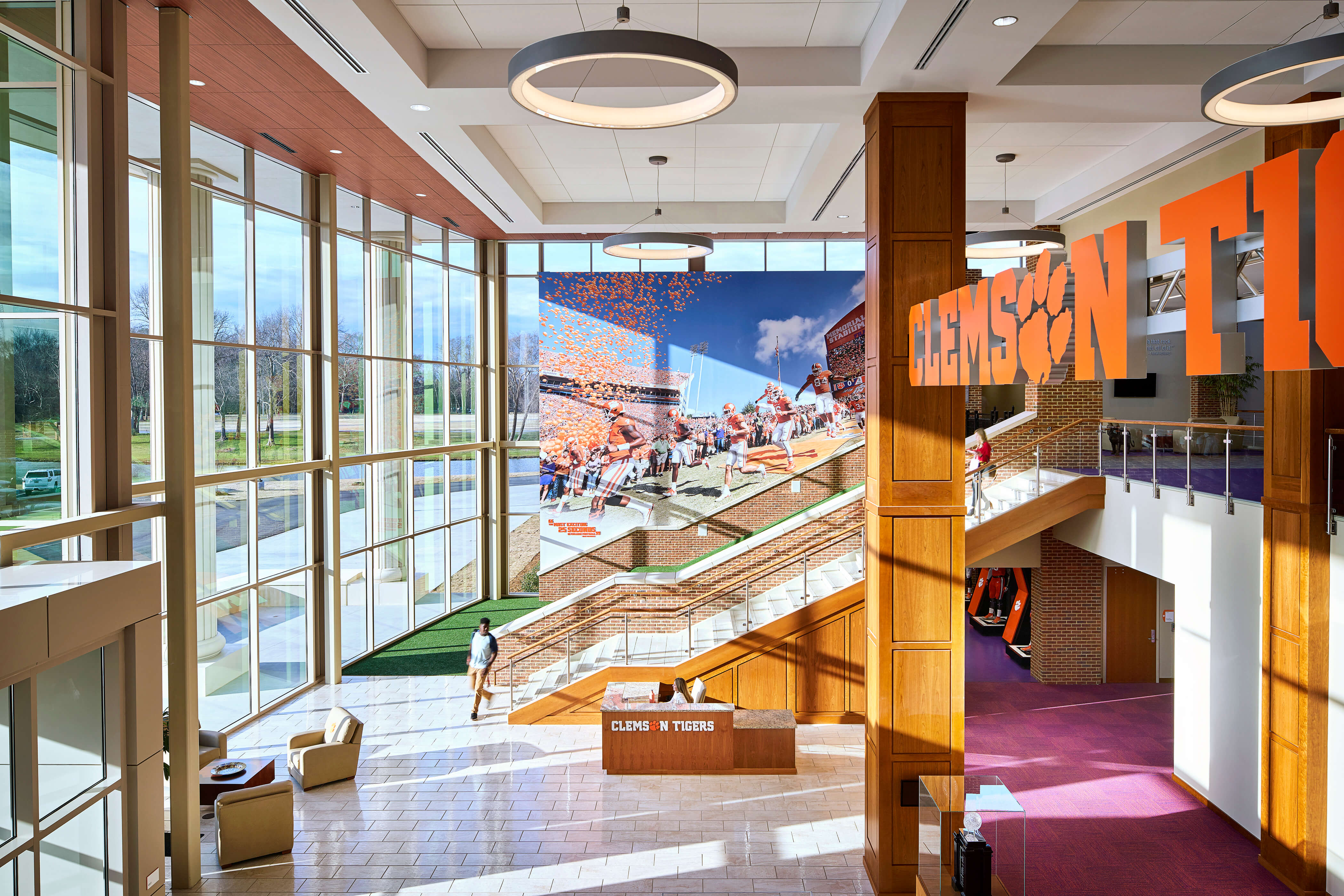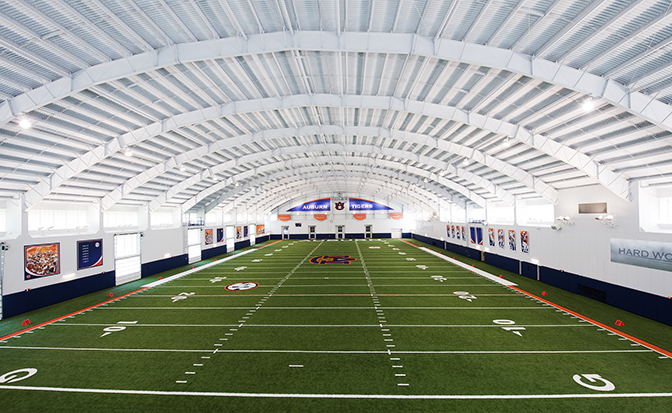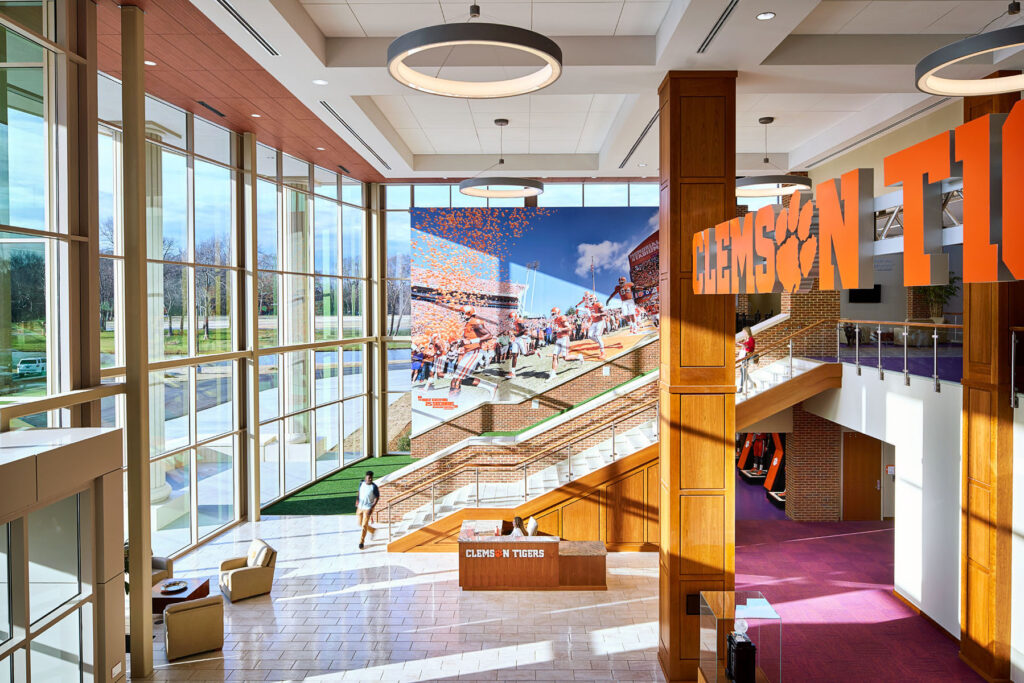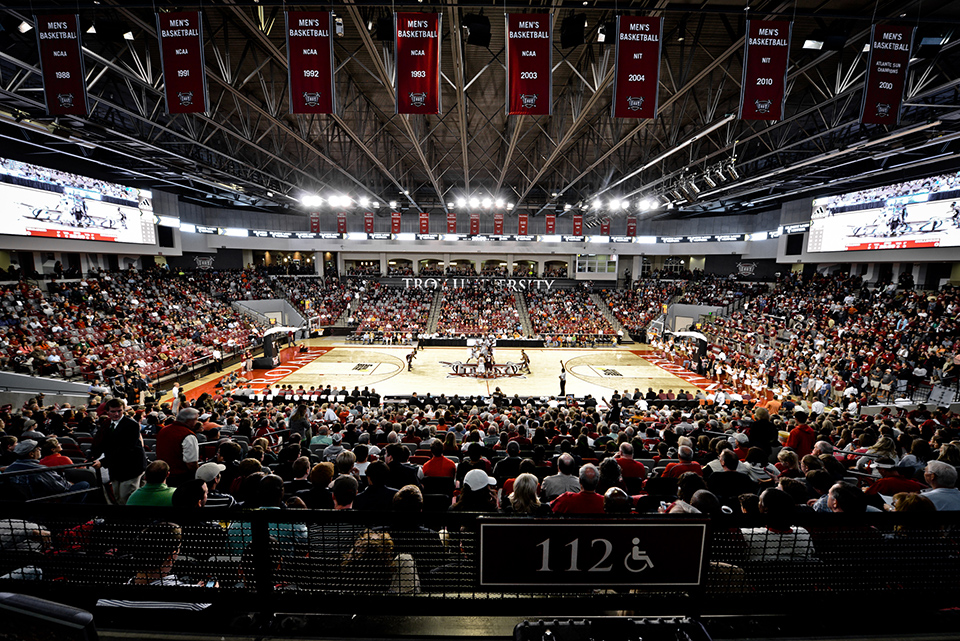Competitive advantage
May 5, 2017 · Insights

An athlete’s experiences on the field, track or court, along with the associated skill sets needed for victory, have real-life applications long after graduation.
This is particularly apparent in the field of athletic design, as recognized by GMC’s consortium of former collegiate athletes turned designers.
Designing with the Athlete in Mind
Yann Cowart, a football walk-on at Auburn University in 1982, serves as the Vice President of GMC Sports – a specialty market within the Architecture Division dedicated to athletic facility and sports-related design. Through Cowart’s years at Auburn earning dual degrees in architecture and building science, while also enduring the demands of football, he learned first-hand that struggles are a necessary precursor to success. “I understand the mentality of a football player and how they move through their day and what’s important to them,” Cowart said. “The core of that, the effort that goes into preparation and the personalities involved … it’s an advantage to be able to relate.”
The physical aspects of preparation, as well as the necessity to maximize time, is something the staff at GMC understands. The “20-hour rule” in college athletics is a prime example. “There was a time when they could practice you four times a day,” Cowart said. “Now they can only have them for 20 hours a week, and that includes everything … practice, meetings, watching film. Every hour is precious.”
For this reason, the athletic designer’s goal is to maximize the efficient use of time and movement when designing sports facilities. “You want to eliminate as much dedicated circulation space as possible,” Cowart said. “In other words, you go directly from the locker room to the training room. You don’t walk out of a space and walk back in. If I can save you 20 steps a day, then I’ve given the coach another 10 hours a year.”
The recruitment side of sports also plays a more important role in design than in the past. For example, amenities within athletic facilities are a big draw, and can include such diverse design elements as barber shops, nap rooms or couches. “It’s a bit of an arms race,” Cowart said. “While it’s about amenities and what makes this space nicer than someone else’s, it’s also about building everyday functions into the environment to maximize time. The student doesn’t have to leave the facility to perform those everyday functions. People think of these as being a perk, but in reality it’s more about taking advantage of the situation and preserving time.”
At Clemson University’s new indoor practice facility, a 36- by 19-foot video board runs a potential recruit’s highlight reel as he tours the facility. It can also be used to instantly re-run film as a teaching tool during practice.
As the recruitment process has become more competitive, budgets have grown exponentially. “When we designed Auburn’s indoor facility in 2011, it was the largest in the SEC,” Cowart said. “Since then, Georgia and others have announced that they will have their own indoor practice facilities. Auburn’s cost $11 million to build; Georgia is building one that is $23 million.”

When considering the millions of dollars invested and earned, an inspiring or reflective design that supports an owner’s visionary goals and a clear understanding of the budgetary pressures of modern-day athletics is crucial.
As the design team sees it, what they do as designers is more than just a business; it is the opportunity to encourage others to grow and provide service above self. In athletic facilities, that service is unique because of the strength gained through the highly visible life experience of the athlete.
Sustainability, functions and maintenance are always concerns, but one aspect of design that GMC can offer clients, due to personal experience, is environments that specifically support a culture desired by the client.
Something as simple as the design of a locker room that focuses on senior or veteran leadership can support a culture of respect, honor and perseverance by centering or exalt the senior locker space that is transparent and in full view of the entire team. The placement of that space and behavior within that space speaks aloud to all other members of the team or organization, psychologically. It also conveys the importance of the culture that the designers hope will be reflected in the lives of team members as future leaders in society.
Of course, athletic architecture is not limited to football. Rachel Crafton-Stiver ran track at Kent State University from 2005-10, as well as earned her bachelor’s and master’s degrees in architecture at the school, and brings her own unique perspective to the table.
“When we were competing in college, we had the opportunity to travel and see several different facilities,” Crafton-Stiver said. “We saw what works well and what didn’t work.” During indoor track meets, in particular, she remembers distinct design flaws that she hopes to correct one day in her own designs.
“As former student-athletes we are thinking more about the players than an architect with no athletic background,” Crafton-Stiver said. “Even though we want to please the owner, it is more important to meet the needs of the daily users – the athletes, coaches and training staffs. They all have a critical role in how practice operates and how successful an athlete performs during competition.”
Home-Team Advantage
Often, GMC’s athletic designers are asked to work at their alma maters, a chance they rarely let pass. Cowart, who has had a presence at Auburn University for several years, is currently involved in the design of Auburn’s $145 million north end zone renovation, scheduled to break ground later this year. Although GMC was partnered with HOK, the university asked Cowart to come off the team and work for them on the owner’s side – which is a new venture for the firm, working as the owner’s representative on an athletic project.
GMC’s athletically-inclined design staff also includes Mike Keeshen, senior vice president of architecture in the firm’s Greenville, S.C., office and a former member of the Tiger track & field team and engineer Kevin Laird, a regional vice president in Greenville and a punter at Clemson University in the 1990s. “My time at Clemson taught me everything from time management to bouncing back from defeats to dealing with adversity,” Laird said. “As a kicker, it’s more mental than physical. The world is falling down around you and you have to keep your cool and do your job.”

Keeshen, whose expertise encompasses higher education and athletic facilities, oversaw the design of the new football operations building at Clemson with aid from Laird. While Laird normally designs utility projects, he couldn’t pass up the opportunity to work at his alma mater. “Nobody had to ask me,” he said. “Obviously I wanted to be involved in it, and we have been doing everything we can to make sure the client is happy.
At the grand opening for the Tigers’ new football facility, Clemson University President Dr. Jim Clements referred to the building as “145,000 square feet of the best of everything.” The complex is the largest and most programmatically inclusive football-specific training facility in the nation and will serve as a home away from home for many of the users.
Designed to allow student athletes to train, study and unwind in the same place, the facility features 1.5 acres of outdoor leisure and entertainment space, state-of-the-art hydrotherapy, training, weight equipment and technology, a steam room and recovery room and a Gatorade fuel bar. The design maximizes adjacencies and functionality, with a centralized player concourse that allows coaches and athletes to move efficiently through their routines and better utilize valuable practice and training time. The concourse is connected to the lobby through a slide, bringing Coach Swinney’s focus on fun to the forefront in the design. The complex also features miniature golf, bowling, a movie theater, gaming lounge and basketball, volleyball and bocce ball courts, giving players an opportunity for some friendly competition.
“This was truly my dream,” said Swinney at the grand opening. “I wanted to move the best team in college football into the best building in college football, and that’s exactly how it worked out.”
A Designer Down South
As GMC’s reputation as a sports design entity grows, universities and sports franchises in the Southeast will have the opportunity to lean upon a design firm in their own back yard. “The South is all about college football and it means a lot to a lot of people,” Cowart added. “To understand the culture and the nuances of the client you’re dealing with … that’s not something that you intuitively get if you live in Kansas City.”
